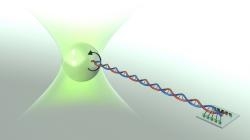In science, it can be fun and interesting to upend conventional wisdom. A good example is what just happened to a widely accepted explanation for overstretching of double-stranded DNA (dsDNA). Overstretching occurs suddenly when researchers add a tiny increment of force to dsDNA that is already experiencing a pulling force of approximately 65 pN. (A piconewton is a trillionth of a newton, which is roughly equal to the gravitational force on a medium-sized apple). The small additional force causes the dsDNA to suddenly become 70% longer — as it stretches like a slinky.
The mechanism for such DNA overstretching has been the subject of active debate for the last 15 years. In 2009, however, most biophysicists were sure that a Dutch group had finally done the definitive experiment: They saw that the extra force caused single strands of DNA to peel apart starting from either broken bonds in the DNA backbone (nicks) or loose-hanging single DNA strands (free ends). In fact, researchers from Northeastern University and the University of Minnesota declared this work the “smoking gun” and the matter was settled; the mechanism of overstretching was force-induced peeling from free ends or nicks.
Recently, however, research associate Hern Paik and Fellow Tom Perkins began to wonder what would happen to dsDNA in an overstretching experiment if it didn’t have any nicks or free ends. Paik devised an elegant experiment in which he could make a sample with no nicks or free ends, but still leave the DNA free to twirl around. To allow for this rotation, he attached a small loop of DNA to a longer DNA molecule. Importantly, the loop contained a single chemical group that the researchers used to attach the loop to a bead that could be pulled by an optical trap. The resulting single attachment allowed rotation of the DNA with respect to the bead. Paik fastened the other end of the DNA via both its strands to the surface of a glass slide, a geometry that eliminated any free ends.
In a series of carefully constructed overstretching experiments, Paik found that when he tugged on this dsDNA at 65 pN, it still increased in length by 70% — even though it contained no nicks or free ends. The new experiment showed the smoking gun wasn’t conclusive after all. Clearly, the sole mechanism for DNA overstretching is not peeling. The challenge now is to explain why dsDNA that lacks nicks or free ends overstretches at the same force implicated in force-induced peeling.
“Our data, in conjunction with prior work, suggest that there are two distinct structures produced by overstretching dsDNA,” says Perkins. “Since the two structures appear to have similar mechanical properties, they may lie at the root of this controversy.”
One structure is the peeled DNA seen by the Dutch group. The big question now is: what is the other structure? It may be molten DNA, or M-DNA. M-DNA would be created if dsDNA internally melts into a pair of parallel ssDNA during overstretching. This mechanism would not require nicks or free ends. Another possibility is that a new form of dsDNA, called S-DNA, appears during overstretching. In S-DNA, the base pairs would remain intact, but the DNA double helix would unwind into a straight ladderlike structure that is approximately 70% longer than the classic double-helix structure of dsDNA.
Paik and Perkins are now working to better understand what actually happens during overstretching. They want to see how temperature, acidity, and salt concentrations effect overstretching and thereby determine if overstretched DNA (without nicks) forms via M-DNA or S-DNA. Their goal is a deeper understanding of the science of DNA overstretching. This understanding will be invaluable for the development of DNA as a standard for forces between 0.1 and 100 pN (See JILA Light & Matter, Winter 2008). - Julie Phillips



 The Physics Frontiers Centers (PFC) program supports university-based centers and institutes where the collective efforts of a larger group of individuals can enable transformational advances in the most promising research areas. The program is designed to foster major breakthroughs at the intellectual frontiers of physics by providing needed resources such as combinations of talents, skills, disciplines, and/or specialized infrastructure, not usually available to individual investigators or small groups, in an environment in which the collective efforts of the larger group can be shown to be seminal to promoting significant progress in the science and the education of students. PFCs also include creative, substantive activities aimed at enhancing education, broadening participation of traditionally underrepresented groups, and outreach to the scientific community and general public.
The Physics Frontiers Centers (PFC) program supports university-based centers and institutes where the collective efforts of a larger group of individuals can enable transformational advances in the most promising research areas. The program is designed to foster major breakthroughs at the intellectual frontiers of physics by providing needed resources such as combinations of talents, skills, disciplines, and/or specialized infrastructure, not usually available to individual investigators or small groups, in an environment in which the collective efforts of the larger group can be shown to be seminal to promoting significant progress in the science and the education of students. PFCs also include creative, substantive activities aimed at enhancing education, broadening participation of traditionally underrepresented groups, and outreach to the scientific community and general public.